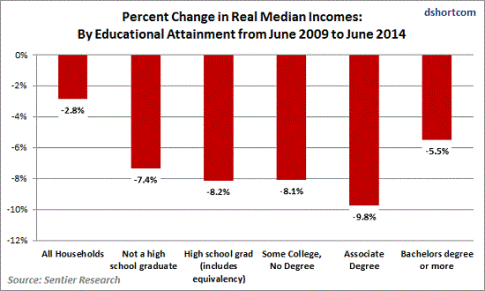– Is the $5 Bill the New $1 Bill? (Of Two Minds, Aug 23, 2014):
Events, food purchased away from home and live entertainment are increasingly unaffordable to the bottom 90%.
It’s starting to feel like a $5 bill is the new $1 bill: everything that could be purchased with one or two dollars not that long ago is now $5 or even $10. A few days ago I was enjoying the Butte County Fair in California’s farmbelt (the Central Valley), and it seemed like a rural county fair was a price baseline that was far enough away from the urban artifice of $100 meals at fancy bistros to reflect the statistically elusive real-world inflation.
Everything was $5, or close to it: the carnival rides for kids: $5. The games (ring toss, etc.): $5. Funnel cakes, cotton candy, etc.: $5.
Whatever wasn’t $5 was $10: pulled pork sandwich, etc. There was almost no need for $1 bills, except at the admission booth: adults, $8/day, kids/seniors $4.
So let’s add up the costs for a family of two adults and two kids. Let’s say the kids each get four rides–that’s 4 X $5 = $20 X 2 = $40. Each kid gets two food items: $5 X 2 = $10 X 2 = $20, and gets to play two games: $5 X 2 = $10 X 2 = $20.
That’s $80. The parents get something to eat and maybe play a game or two: that another $40. The admission fee is $16 for adults and $8 for the kids, $24. Parking is $5.
The family spends about $150 at the county fair for a day. Add an extra kid or a few other purchases and the cost pushes up to $200.
This trend of $5 being the minimum purchase price and outings costing $200 is not unique to county fairs. Some friends attended a S.F. Giants baseball recently, and they were delighted to buy seats online for a discounted price of $64 each. Add in $25 parking (or $20 in BART train fare) and a few $10 cups of beers and $10 hotdogs, and it costs $200 for two people to attend a major-league baseball game (at least in a desirable locale with a winning team).
Now I readily confess to being frugal. Not making much money for extended periods of time tends to encourage frugality. Frugality is also only way most of us non-silver-spoon types can accumulate capital (savings) to invest in ourselves and our own enterprises.
$200 seems like a lot of money when I think of what else it can buy. $200 bought all the gasoline for our 2,000-mile camping trip last summer (our 1998 Honda Civic gets 40 miles to the gallon on the highway), and all the groceries for our household for a month (recall we have a garden, eat low on the food chain and shop almost exclusively at Costco and ethnic markets).
$200 will buy a new Skil 77 worm-drive Skilsaw ($149.99) or a new designer-label men’s suit at a premium outlet (after being dragged to the outlet by foreign friends awhile back, I bought an excellent Calvin Klein suit for less than $200 that will last decades).
Meanwhile, earned income is declining when measured in purchasing power. The median household income in Butte County is about $43,000, and $54,000 nationally.
Courtesy of chartist extraordinaire Doug Short, here is a chart of the changes in median household income since June 2009:
How long can households afford $200 outings as their real (adjusted for purchasing power) incomes continues eroding?
We are constantly reassured that inflation near-zero–2% annually or less. On the ground, it seems that stuff manufactured in the global supply chain is still relatively cheap, as are energy and food, at least compared to what they cost elsewhere or could cost if supply chains get disrupted.
There are no limits on the cost of government services or government-controlled sectors such as healthcare. Our city garbage service fees just jumped from $356 quarterly to $453, a 27% increase. Note to Federal Reserve: 27% is not 2%.
Our monthly healthcare insurance (paid entirely by us, as we’re self-employed) leaped $300 per month over the past few years, from $900/month to $1,200/month. These increases add up to thousands of dollars a year. That is not 2% inflation.
Clearly, healthcare, government services, events, food purchased away from home and live entertainment are increasingly unaffordable to the bottom 90%.

Surprisingly accurate. Gas has gone up better than 4:1 over the last decade, food has and continues to skyrocket in price. Beef up 400% over last 2 years, chicken 300%, fruit 300%, drinking water up 50% in last 4 months…..bread is $6.00 a loaf for decent quality, or fresh made……$5.00 is like a dollar. You cannot buy two items and get out of a store for less than $10.00…..it is going up fast as the dollar loses value.
Dollar is losing value because more than half the world has ceased to use it…..this story is as carefully hidden from American propaganda viewers as Fukushima.
I was watching for it, anyone with half a mind had to expect this, and found it when Hugo Chavez started it in Spring of 2010. I watched and followed, scratching all over every source I could find, and found China and Russia picked up his model in November, 2010, and I knew what was coming. The story has already been laundered since I found it.
Now, the east is picking up all the solvent states, and the west keeps the bankrupts…….we are sliding south faster and faster….Switzerland joined Putin’s basket of currencies, ie: BRICS two weeks ago. Nobody with any money is staying with the US.
Not paying Germany their gold was a huge mistake. Now, the world knows the truth…..the US is broke.